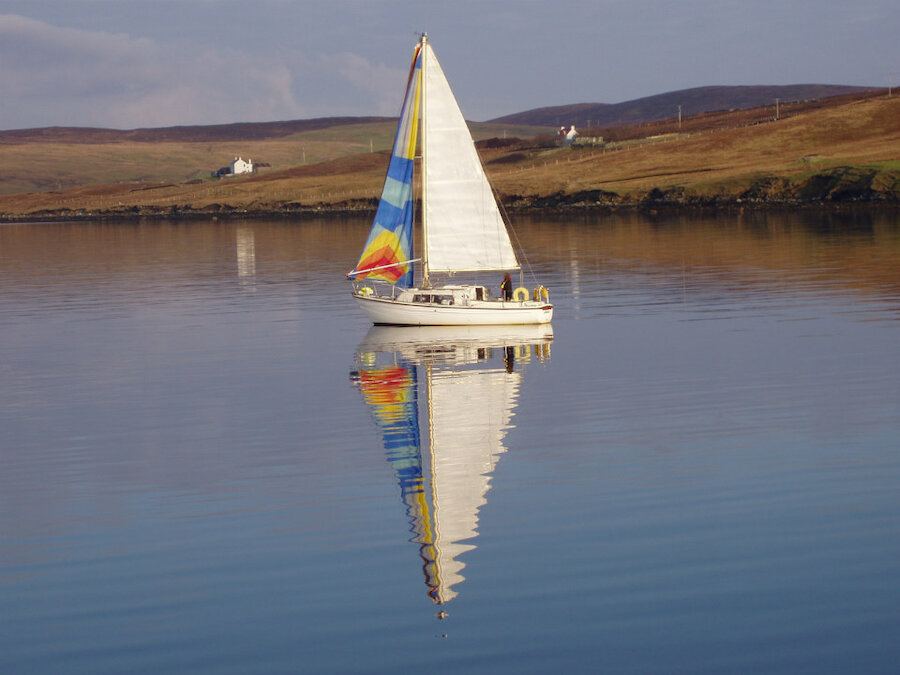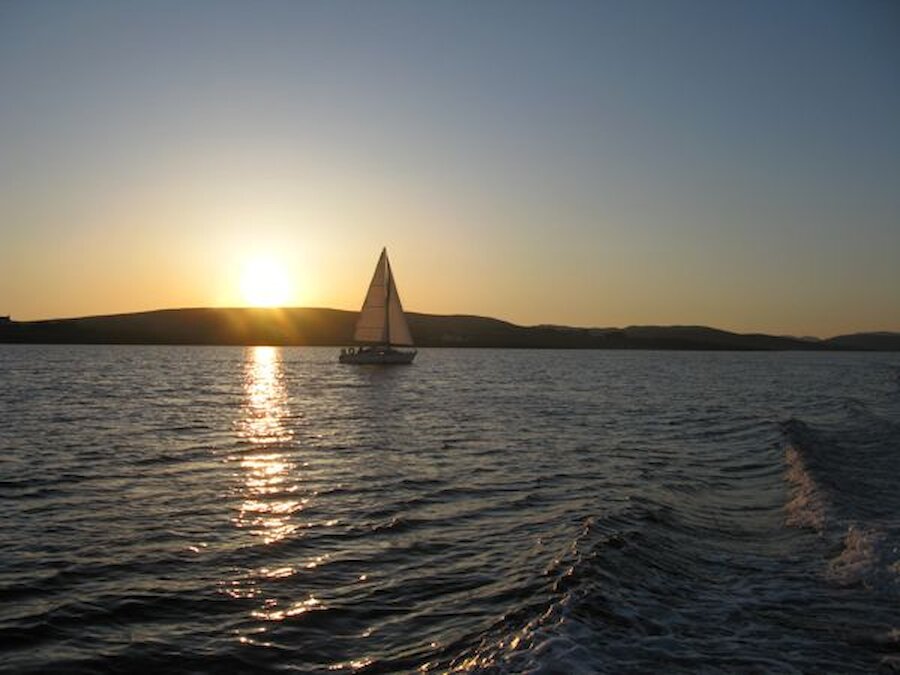Local yacht skipper and dinghy instructor Marsali Taylor describes Shetland's sailing scene.
The 13th of November turned into a bonny afternoon, so I headed out for a sail. Most Shetland villages have a small marina, and ours, in Aith, is so handily close to the house that I reckon on 20 minutes from crossing my doorstep to being out on the water with sails hoisted and engine off. Today was a personal best: 17 minutes before I pulled the "Stop" handle and the clank of the engine faded into silence.
After a week of gales, it was wonderful being out on the water. I had a light wind behind me, and my 8 metre yacht, Karima S, steered herself nicely while I made a cup of hot chocolate and found the last of the chocolate stores. A couple of young guillemots, speckled grey and cream, bobbed up beside me. I sailed north for a couple of miles, and didn't turn back until the street-lights lit up in Aith. Then I had a fast beat home, with the wind in my hair, and the water chuckling under Karima's prow.
Visiting yachts often head up the east coast towards Lerwick, Shetland's capital. My sailing playground is on the west, Swarback's Minn, a spread hand of water opening out from the Atlantic, but protected from the worst of the gales by green hills and red sandstone cliffs. Puffins nest here, and kittiwakes; seals bob up close to the boat, and otters bustle along the shoreline. Within 12 miles of my own berth, I have two more marinas (both near excellent seafood restaurants), several piers and two pontoons in beautiful, deserted bays, if I fancy a night under the stars. Karima S's mast stays up all year, and I manage to get at least one trip on the water every month. Getting out on Christmas Eve afternoon, when everyone else is fighting supermarkets, is a bonus.
My summer sailing season is divided between messing about single-handed from Aith and serious racing up at Brae, the largest marina on the west side. It has 54 berths, and Shetland's most active yacht racing fleet. Masts go up there in April, and there's racing every weekend through May and June. It's not all around the cans; Karima S and I join them from Aith for overnight stays at the western island of Papa Stour, or Sunday lunch at a bay called the Hams – the old Viking word for a good mooring. We race around for the Mavis Grind Foy – an afternoon of sideshows and music – and there has to be some kind of flotilla expedition for the summer solstice, which generally involves a fire on the beach, a barbecue, and staying up past midnight to enjoy the sun dipping below the horizon, then rising again.
In July, the regattas begin: Brae first, then Aith, then the fleet works its way around the west side via the villages of Walls and Skeld to the former capital, Scalloway. After that the yachts go down around Sumburgh Head, and up the east coast to Lerwick for the big Inter-Club, followed by the Lerwick Regatta. The regattas aren't just about racing, though many of the trophies are over 100 years old, and solid silver; they're also about having a good time, with a disco on the Friday night, a slap-up meal in between races on Saturday, and a dance in the evening. Most have a fishing competition, with the catch barbecued, and many also feature rowing races in the traditional Shetland yoals.
It's not just adults that sail. Over the first weekend in May, we instructors haul the club dinghies out of the shed and put word round that classes are about to start again. They run on Mondays and Tuesdays in Brae, through May to September, and Delting Boating Club also hosts week-long courses for youngsters throughout the summer holidays. Lerwick Boating Club runs classes too, in Picos and 420s, and Sandwick, in the south end, has a thriving Mirror fleet. Youngsters from these clubs regularly compete at national level, and the best go on to represent Shetland all over the world in the Inter-Island Games.

